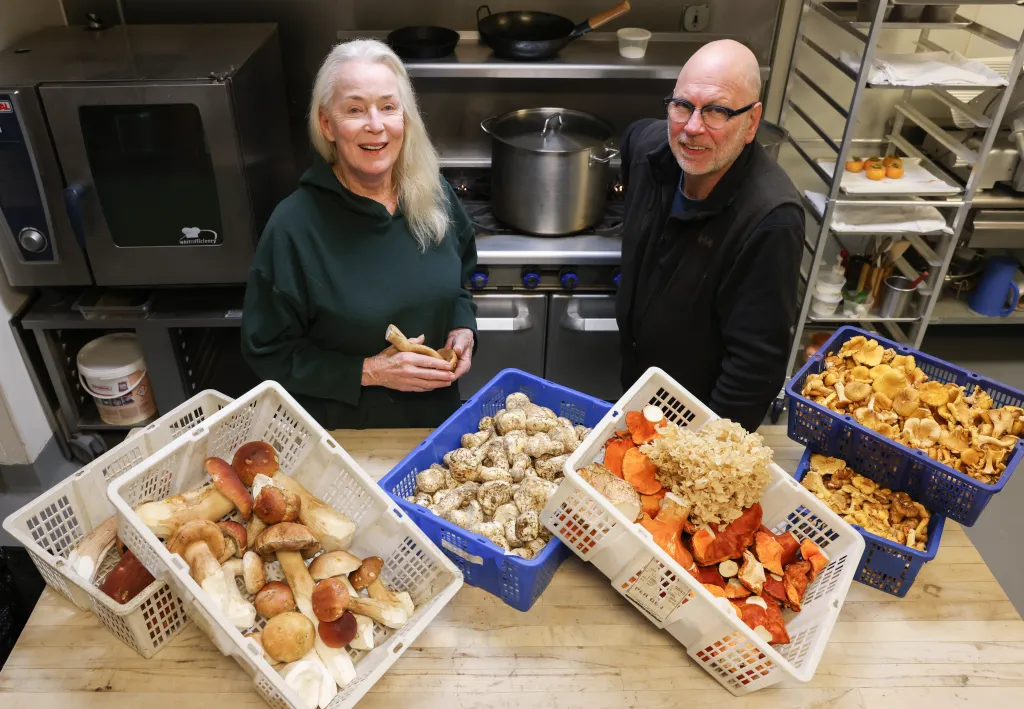Copyright Santa Rosa Press Democrat

Connie Green has been foraging since she was a small child growing up in ‘old’ Florida. Her family had lived in the area for seven generations and were very familiar with the local wild foods. Her early experiences of the joys of foraging led to a life-long practice, recognized expertise and a highly successful Napa business called Wineforest Wild Foods. She noted that here and in Europe it’s often one’s grandmother who first teaches us how to forage for wild foods. “Picking berries with one’s grandmother is a very common thing and certainly this happened with me,” she said. “So wandering about and picking Catawba grapes and blackberries was where it began for me, like it has for people throughout human history really.” Another of the first traditional forages for many children is the Easter egg hunt. “It sort of feels at times like my life has been one long Easter egg hunt because of a long life of finding things,” Green said. “That evolved into finding mushrooms.” In 1979 Green and her late husband moved to the Napa hills where she has enjoyed foraging for decades. “It’s kind of a wild country up here,” she said. “And in some ways it’s gotten wilder because after the fire, so many homes have not been rebuilt. You know, bears used to be rare, and now we have bears again.” Mushroom business Green founded Wineforest Wild Foods in 1981. It’s one of the oldest mushroom businesses in the country and she is considered one of the pioneers of the wild food movement in the United States. Her business continues to thrive more than 45 years later. She’s also working with a network of foragers she formed decades ago. When speaking with Green it’s clear that to her, the best part of it all is simply being out on the land foraging. California is known for having many different microclimates and very diverse habitats. Green said that within a 100 mile radius, there’s a surprising amount of diversity. “It’s something that’s quite special and almost rare that occurs here,” she said. “For instance, I live in an interior oak habitat and yet I can get in my car and drive 40 minutes to the west and I will be in a completely different habitat. It’ll be conifers with moisture and fog. I’m a big fan of various conifer needles and many mushrooms that people aren’t as familiar with. We have porcinis that are more towards the coast. In the interior where I am, we have some of the most popular mushrooms like chanterelles. We have berries, elderberries, elderflowers, and so on. There’s a lot of stuff up here.” Green said her favorite is hunting for chanterelles and elderberries and what she enjoys most about foraging is that it offers her the ability to wander in the woods with a childlike focus in the environment around her. “You know, you leave troubles and news and newspapers and emails, you leave all of that behind,” she said. “In order to be a good forager, to be a good gatherer of things, you really have to have a moment by moment type of focus on the world around you and this is an extremely lovely experience.” That’s helpful when hunting for chanterelles, Green said, because at first you might only see 20% of them, and then for the other 80% you have to look around. She said the key is the tree. “You learn the host tree because most of the great edible mushrooms are mycorrhizal, and this means they’re married to a tree,” Green said. “In the case of chanterelles, here in this habitat it’s interior and coastal live oaks, but if you go to the west you’re going to find them under say, Douglas firs and other trees.” Green explained that picking mushrooms is like picking apples from a tree. The difference is that they are living underground around the roots of their host tree. She explained that the mushrooms themselves are the fruit, which is why she likes the analogy of picking apples. Chanterelles like the rain and Green said she’s seen huge patches pop up after big rainy seasons. “We had two years that were absolutely extraordinary in 1982 and 1983,” she said. “These were two years where we had extreme rains.” Green has been harvesting from many of the same patches for 45 years. She said there have been times during periods of drought that the mushrooms didn’t appear, but they eventually do return. She said the secret to this is the mycelium, the root-like structure of the fungus, that is still there underground. “It has just decided that it’s unsafe,” she said. “The organism wants to save its strength for reproduction, just like animals and humans do. The tradition of survival is to retain their kind of life force for when it’s safe to start, you know, spreading spores or seeds or whatever.” Chanterelles also dislike fire and can disappear for years after a fire has scorched the ground or done harm to their host tree. Green has been watching for patches of mushrooms to return to areas that burned during the Tubbs Fire. “I have found a few places where the oaks were burned and yet the tree still lives,” she said. “Oaks are very resilient and some [chanterelles] have begun to appear again after a dormancy. The 2017 fire was about eight years ago and with these early rains, I’m waiting to see if they start growing in some places that I haven’t seen them for a few years.” In the beginning, Green took her foraged chanterelles to chefs in local restaurants and was simply trading them for the cost of a nice dinner. But once chefs had tried her mushrooms, they wanted more — and Wine Forest Wild Foods was born. She laughs as she recounts the story of one disbelieving chef in her early days. “I took them to the number one restaurant in San Francisco and the French chef there told me ‘those aren’t chanterelles, they don’t grow in the United States’,” she said. He was of course wrong. She sells them to numerous San Francisco restaurants where the chefs love her chanterelles. “For years, I only provided fresh mushrooms to restaurants,” she said. “Because our rainy season is limited I was selling mushrooms for only five to six months of the year.” One of the ways she expanded her menu was by carrying cultivated exotic mushrooms as well. Foraging She did note that the warmer California climate creates more opportunity for wild harvested foods than other areas. “In Northern California, we’re exceptionally blessed because our winter isn’t a winter so much as a very long autumn,” she said. “So we have mushrooms in Northern California when they stop everywhere else. We will have black trumpets, hedgehog mushrooms, and yellowfoot mushrooms throughout the winter.” Green likes to forage in the Sierras, Northern California and Oregon and she began to meet other like minded people wild harvesting in those areas. She strengthened those relationships and her business early on by creating a network of mushroom pickers in the West. She is still working with that network for accessing wild foods, which keeps her in good supply while also benefitting those foragers as well. Green said she probably won’t see chanterelles in her area until December but they have already started appearing up north. “So for the last three weeks, my friend has been sending chanterelles down from the Olympic Peninsula,” she said. “And then another person in coastal Oregon is sending mushrooms. This network has existed for decades.” Wild foods Wineforest Wild Foods is primarily a wholesaler and they ship their fresh mushrooms to restaurants throughout the entire Bay Area. When asked which restaurants she works with locally Green laughed and said it would be easier to list those that she doesn’t work with. She did rattle off a few local names of restaurants such as the French Laundry in Napa; Enclos in Sonoma; Benu in San Francisco; The Mathieson in Healdsburg; Boulevard in San Francisco; Glen Ellen Star; and Kenwood’s Stella. In addition, the business offers an assortment of food products such as dried mushrooms and powders that they ship all over the country. They also have a line called Wild Sides, with porcini risotto and porcini polenta. “We have a true wild rice that comes from these wonderful folks in the northern Minnesota lakes,” she said. “We sell real wild rice that has dried mushrooms in it. And then a wonderful forest farro with dried mushrooms in it.” They also sell several shrubs made with wild berries. A shrub is an age old elixir that’s used as a culinary seasoning, as a beverage syrup and is touted for its health benefits. “We started selling shrubs really before anybody else and all four of them have won good food awards repeatedly,” she said. They have a popular elderberry shrub and Green said they were ahead of the game with that one. During the pandemic people became aware of the antiviral properties and the wealth of nutrients of the elderberries and their elderberry shrub became highly sought after. “I pick all the elderberries and have done that for, oh, decades,” Green said. “I love elderberries.” They have a wild huckleberry shrub too. “Huckleberries are one of the most beloved things in the West,” Green said. “And we have a huckleberry along the coast that goes, you know, from probably Big Sur, all the way up to Central Oregon. And it’s an evergreen huckleberry. We use those and mountain huckleberries.” They also sell a sea buckthorn shrub and a haskap berry shrub. “The sea buckthorn is almost like passion fruit,” Green said. “It’s like a Nordic passion fruit. And then the haskap berry tastes like somebody grew blackberries and watered them with port, and it’s this beautifully rich, wine-tasting blackberry flavor. Sharing and teaching Green is co-author of the book “The Wild Table: Seasonal Foraged Food and Recipes.” She highly encourages readers to incorporate wild foods into their menus because foraged foods are fresh and nutritious. But she added that it’s important for foragers to educate themselves about what they’re hunting and to have a degree of humility when harvesting wild foods. That’s because there are also similar plants out there that we should never eat because they are very poisonous. It’s also important to be aware of local foraging laws and where foraging is permitted. In California, most public lands, including national forests and state parks, have specific rules. In some areas, permits are required for harvesting certain plants or mushrooms. It’s recommended that individuals interested in foraging contact local authorities to ensure compliance and avoid penalties. Green said when it comes to foraging, people are much safer hunting the common mushrooms because many of them are extremely easy to identify. She’s reluctant to give the names of a lot of the other mushrooms that grow locally because it takes greater expertise to identify them. For those who are interested in hunting for mushrooms Green encourages people to join a mycological society and noted that the Sonoma County Mycological Association (SOMA) go on forays. “It’s a very smart thing to do because you’re with genuine experts and they hunt in legal places,” she said. Salt Point State Park allows foraging of up to two pounds of mushrooms for personal use. Green said she appreciates those limits so that there’s enough for everyone. “You can also get a picking permit to go into the Sierras or into Mendocino National Forest where you have even more territory,” she said. When harvesting mushrooms Green said it’s helpful to use a basket or a bucket with holes in it so that as you’re walking around you’re helping the mushroom spread its spores to new areas. “By doing this through the decades I’ve had mushrooms come up in places where they never were before,” she said. There are plenty of wild foods to be had throughout the North Bay area and Green encourages locals to enjoy foraging once they have educated themselves. “There is something deeply pleasurable about eating things that are coming out of the very soil and grounds and forests and farms that you live near,” Green said. “It’s part of you. You share your environment with these foods and you are part of it.”



